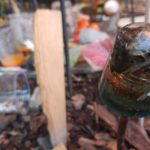Fairy Houses are the latest exhibit in the ongoing transformation of North Brooklyn
Recently, I had the great opportunity to visit a major new real-estate development going up on the hot-corner of Franklin and Oak. The brainchild of the GCEF-funded Greenpoint Eco-Schools, a local organization providing ecological education to local elementary schools, this development makes prime (some might say “convenient”) use of a gated city property, located at the 61 Franklin St. Community Gardens.
“We have something of a sweetheart deal with the ‘powers that be’ behind this development,” notes developer and P.S. 31 Sustainability Coach Alison Schuettinger. “That said, we are beyond LEED-certified, here. The development used all locally sourced, organic, biodegradable materials, working in concert with the existing community. This is no Hudson Yards bulls**t.”
The development consists of a series of Fairy Houses, sited throughout the garden. While clearly an appeal, the deeper pockets washing ashore of late in a rapidly-gentrifying Greenpoint neighborhood, in accordance with the Mayor’s Housing New York plan, a full 33% of the units of the total development profile are devoted to low-income fairies.
Commanding the Northeast corner of the garden, the “Fairy Village” is this low-cost development offering abundant fairy shelter and complimentary tomatoes. With a driftwood roof that the developer promises “will keep fairies really dry when it rains,” and lots of free leaves, Fairy Village is an admirable attempt at continuity with the more upscale aspects of the development, though the building drew some controversy for it’s “Poor Door” location, separate from the development’s main complex.
An almost Nordic amenity, given the clearly NYHA constraints of this development, is the stick slide into a Chamomile candle. Consisting of a simple stick, balanced atop a piece of driftwood — and cheekily positioned to overshoot the actual candle! — the StickSlide is the brainchild (some might say “indulgence”) of Spanish Architect Gael B., 6, and offers patrons a chance to, “Slide down here, into … into this candle.”
When asked if Fairies liked hot candle wax, the architect seemed bemused, as if he’d not considered that detail.
On a whole different plane is the anchor building of this development, sited underneath a Weber barbecue at the western promontory of the garden, adjacent to the compost bins. Here, the altogether surprising architecture supports an impeccably refined vision of luxury, as curated by Greenpoint’s storied Fairy Decor design team of Ximena, Holly, Vivi, and Tennessee. Featuring bespoke details throughout, abundant natural and biodegradable materials, and an extremely open floor plan, “Fairy House” (as it is known) also features a newly commissioned public artwork, “Butterflies” by the artist “Made in China.”
Enviable details include a one-of-a-kind towel drawer, and again, complementary tomatoes. A nice touch are the bespoke fairy lights, which the team assured me “use magic to stay lit at night.” Another unique amenity is a custom wooden-stick shade structure. “Here, if she just, like, likes down here, she can pull this stick and this thing will, like, come down and make shade,” one of the designers explained.
Of course, luxury at this scale begs a significant question: at what point does this sort of leading development not actually respond to existing trends, but exacerbate them? Given that the fairies that have historically called Greenpoint home are of a decidedly less “incomed” group, at what point does such a development pose a threat to the very amenities it seeks to take advantage of? The developers seemed unconcerned about this potential consequence of their actions.
“Can any old fairy afford this sort of Fairy House?” I asked one of the designers.
“Well, maybe not, but we have other places for those fairies, like this,” she explained, pointing out a rather pedestrian-looking collection of of sticks and leaves. “It has kinda a more, like, outdoor thing where you sorta have to sort things out cause it’s a little messy.” she explained, adding, “Little kids made that one.”
One last aspect of the development that caught my eye was what looked like a pile of mud on the Northwest corner of the garden. I must confess, I did not at first recognize this mud puddle as a Fairy House in the traditional sense, given the noticeable lack or ornament, architectural form, or indeed coherent structure. In fact, at first I ignored this house, assuming it was unfinished. However, in architecture–as in any art–one would be wise to recall that the shock of the new often obscures the recognition of great work, and that simplicity often befuddles on first glance: One thinks of walkouts at the Rite of Spring, or the vitriol lobbed initially at Maya Lin’s Vietnam Memorial.
At any rate, my initial ignorance gave way to a transcendent incredulity as I realized what the architects had wrought. I”ll let them speak for themselves:












